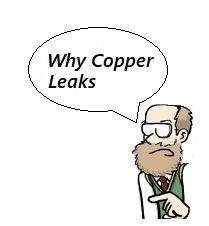Why you are experiencing copper leaks
There are numerous causes for copper leaks (i.e., so-called "pin hole" leaks). Here is a list of causes:
Poor quality installation/sloppy workmanship
Failure to properly clean the joint after soldering. The flux is acid-based and must be wiped from the joint; otherwise, the acid will begin to attack the copper. We find that most joint leaks occur years after installation, but the cause can be traced back to sloppy workmanship.
Deteriorated water heater
Water heaters contain cathodic protective devices; i.e., sacrificial anodes. These devices are rods that are screwed into the tank; they are made of magnesium or aluminium. The rod is designed to deteriorate over time; this deterioration protects the steel surfaces of the tank (the rod deteriorates instead of the steel tank). However, once the rod is fully consumed, natural electrochemical process occurring inside the tank begin to attack the steel tank surfaces. As a result, dissolved metals begin to circulate and collect in the piping system. This contamination flows through the pipes; it slowly precipitates out as a compound that is formed with other minerals dissolved in the water. This precipitate starts to collect on the invert of horizontal pipe runs (the bottom inside surface of the pipe). These deposits begin to attack the copper surfaces, eventually leading to leaks.
Even if you replace an old water heater, the minerals are already circulating through your pipes. Eventually, you will experience leaks. The best preventative measure is to replace cathodic protective devices every four or five years--particularly if you own a "six year" water heater.
Poor electrical grounding/bonding
A less common cause is poor or non-existent electrical grounding of the metallic pipes. The National Electrical Code (NEC), Article 250.104(A) requires metallic water piping to be bonded. However, a more common problem we find is plastic piping and piping components that interrupt the bonding of interconnecting pipes. For example; the addition of a inline plastic water filters, softeners, etc. where the pipe on either side of the device is copper. If you have a non-metallic inline plumbing fixture, the Code requires a bonding jumper be installed across the non-metallic device.
Poor quality copper/used copper
Another less common cause is using poor quality or used materials. In a few instances, we have repaired pipe leaks where a plumber previously installed a used section of pipe--it's rare, but it does occur.

